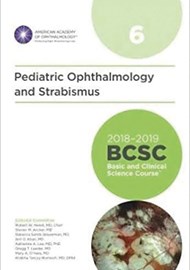The Basic and Clinical Science Course done by the American Academy of Ophthalmology (AAO) is a firm favourite, not just in the US, but across Europe as well. We’ve reviewed a few updates to their series, and I was happy to have a look at their update to the paediatric and strabismus book. This was actually released for 2018-2019.
Dare I say this might be my favourite one yet? I love that it has everything you need in one book. You don’t need to refer to other texts to recap anatomy or physiology – It’s all there. I’ve always been a fan of how AAO has little QR codes so you can quickly look at some multimedia. They make great use of it in this text too. Reading about visual acuity cards for kiddos can be a little dry or difficult to visualise. Here, you have plenty of pictures but the odd video too. There’s also this nifty little activity to help you understand what extraocular muscles are responsible for what movements; something that can still confuse even senior trainees. If you want to quickly reference a video you’ve seen, don’t worry, you don’t need to whip through the text to find the page that QR code is on. At the front they have a QR code which takes you to a page which has all the videos for the text.
The very first chapter of the book talks about paediatric eye examination and gives some tips about what you can say to children to help them feel at ease or get them on board with trying to get on a slit-lamp. The advice in this section was surprisingly polarising and I accidentally started an argument between two ophthalmologists when I mentioned the book said you could ask the parent to bring baby in hungry so they can feed them during the examination to keep them preoccupied (no, they didn’t come to an agreement as to what was best, they instead started arguing over who had the best toys to keep kids distracted. I’m personally on team disco ball pen). If you’ve never encountered children in an ophthalmic setting before this section can be quite helpful. If you have dealt with kids before or had the joy of watching a consultant paediatric ophthalmologist charm a child in clinic with toys and nursery rhymes, then you can probably skip over this bit.
After this first initial chapter it then splits itself into two parts; part one is strabismus, part two is paediatrics.
The first chapter on strabismus talks about terminology and for me, it was the first of many lightbulb moments I had when reading the text. This is when I started to realise what some of the strange gobbledygook that orthoptists scrawled meant. Turns out it does make sense. This is then followed by some basic science which is really important to understand; anatomy of the extraocular muscles, motor physiology and sensory physiology and pathology. You are then taken through amblyopia, eso, exo and vertical deviations, pattern strabismus, motility disorders, childhood nystagmus (with lots of videos) and then finally surgery on the extraocular muscles. So, it is pretty gosh darn comprehensive.
You then move onto part two which is the paediatric ophthalmology bit. It’s extensive without feeling overwhelming. As always, there’s a pleasing number of pictures and summary tables. There’s a particularly useful chapter at the end, with ocular manifestations of systemic disease which apparently comes up in exams quite often. Then finally you have some multiple-choice questions to test and consolidate your knowledge.
So, as always, AAO delivers a superb text which is easy to understand and read. It’s a winner.




